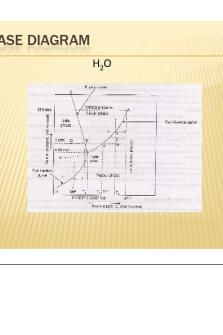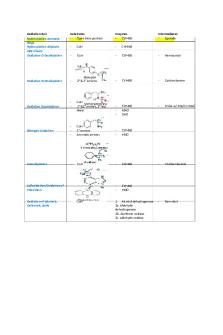Phase Rule PDF

| Title | Phase Rule |
|---|---|
| Author | Him Sk001 |
| Course | Chemistry |
| Institution | Dibrugarh University |
| Pages | 21 |
| File Size | 10 MB |
| File Type | |
| Total Downloads | 16 |
| Total Views | 169 |
Summary
Phase equilibrium...
Description
PHASE DIAGRAM H2O
ONE COMPONENT SYSTEM This system consists of three curves OA,OB and OC, three areas AOC, BOC and AOB, a triple point O and only one metastable curve OA’ ´ Curve OA : It represents following equilibrium li id ↔ vapour liquid Curve start from O and extends up to critical temperature (3740 C) at critical pressure ( 218) ´
Here P= 2 and C= 1 Applying Phase Rule F= C- P +2 = 1- 2+ 2 =1 Hence the system is univariant Curve OB: It represents the following equilibrium Solid↔ Vapour ´
. Curve starts from O (FP) and extends up to absolute zero. Here P= 2, 2 C= 1 Therefore, F= C-P + 2=1 Since the degree of freedom is one, hence the system is univariant. ´
Curve OC: It represents solid liquid equilibrium Solid ↔ Liquid Here P= 2 2, C= 1 Therefore, F= C- P+ 2= 1 Hence the system is univariant. ´ Curve OA’: It represents the liquid waterwater vapour in metastable equilibrium. ´
POINTS ´ Triple point O: It is the point at which all the three phases, phases ice, ice water and vapor coexist in equilibrium. The three curves OA OB and OC intersect each other at OA, point ‘O’. This is called triple point. P= 3, 3 C= 1 ´ Here F= C -P +2
. = 11 3+2 = 0 since the degree of freedom is zero, hence the system is invariant. AREAS,between the lines: (i) Area AOC: The area abov the curve OA i.e., consists of liquid phase only. P= 1 1, C= 1 F= C- P+ 2 = 1- 1+ 2 = 2
. (ii) Area AOB: This area represents only vapor phase. Hence the degree of freedom is two i e the system is bivariant i.e., bivariant. (iii)Area BOC: It represents only solid phase. Degree of freedom is two, so it is also a bivariant system.
PHASE DIAGRAM CO2
ASSIGNMENT What is one component system. Explain an one component system with well labelled phase diagram. ´ Compare water system with carbon di- oxide system. system ´
TWO COMPONENT- SIMPLE EUTECTIC SYSTEM Pb– AgSystem
TWO COMPONENT CONGRUENT M.P. SYSTEM Zn– MgSystem
ASSIGNMENT What do you understand by eutectic system? Explain Pb- Ag system with well labelled phase diagram. ´ Define the term congruent melting point. Explain Zn- Mg system with well labelled phase diagram. ´
INCONGRUENT M.P. SYSTEM Na2SO4‐ H2O
SODIUM SULPHATE- WATER SYSTEM Sodium sulphate forms following phases: ´ 1. 1 decahydrate ´ 2. heptahydrate ´ 3. anhydrous sodium sulphate rhombic ´ 4. monoclinic form ´ 5. ice ´ 6. Liquid phase ´ 7. Vapour phase ´
The vapour phase can be ignored. ´ The Sodium-Sulphate Water system is a six phase condensed system. ´ The system consists of four curves and three points. 1.The curve AB (The melting point curve of ice) A is the melting point of ice, curve RS shows the lowering of melting point of ice on the addition of anhydrous sodium- sulphate. ´
Applying the reduced phase rule F = C – P+ 1 =2–2+1 =1 Thus the system is univariant. univariant 2.The curve BC( The solubility curve of sodium ´
sulphate decahydrate) : Along this curve, curve saturated solution of sodium sulphate and sodium sulphate decahydrate are in equilibrium. Curve BC shows the solubility of sodium sulphate decahydrate increases with temp. until the point C is reached.
.
. Applying the reduced Phase Rule F = C – P+ 1 =2 –2+ 1 =1 Thus the system is univariant along the curve 3.The curve CE (The solubility curve of rhombic sodium sulphate): If heating is continued at point T, all the sodium sulphate decahydrate will disappear and only two phases i.e., anhydrous sodium sulphate and solution will will be be left left. Applying the reduced phase rule: F = C – P+ 1 =2–2+1 =1
.
1.The point B ( Eutectic point) : ´ At this point B, three phases (ice, sodium sulphate deca hydrate and solution ) coexist in equilibrium. Applying reduced phase rule : F = C – P+ 1 = 2 – 3+ 1 =0 ´ Thus the system is nonvariant at this point. 2. The point C ( The Transition point): At point C, the sodium sulphate decahydrate decomposes into the anhydrous rhombic sodium sulphate. So the temp. corresponding to this point “C” represents the transition temperature (32.4). This temp. may also be regarded as the incongruent melting point of sodium sulphate decahydrate.
´ .Applying the reduced phase rule
F = C – P+ 1 =2-3+1 =0 ´ Thus the system is invariant. 3. The point E (The transition point): At this point , the anhydrous sodium sulphate exist in rhombic, monoclinic and solution form. So applying the reduced phase rule rule. F = C – P+ 1 =2-3+1 =0 ´ Thus point “E” is also invariant point.
.
ASSIGNMENT ´
What do you understand by incongruent melting point system? Explain with labelled phase diagram....
Similar Free PDFs

Phase Rule
- 21 Pages

Calc diff Rule prod Rule
- 4 Pages

Literal rule and mischief rule
- 9 Pages

Phase Diagram
- 4 Pages

RULE OF LAW - Rule of law essay
- 4 Pages

Phase 1 and phase 2 reactions
- 8 Pages

TRAFO 1 PHASE DAN 3 PHASE
- 13 Pages

Bias rule
- 5 Pages

Postal rule
- 6 Pages

Rule of Law - Rule of Law
- 5 Pages

Credibility Rule
- 19 Pages

Corr TPHill Phase Photochimique
- 4 Pages

PHASE 1: STRATEGIC PLANNING
- 1 Pages
Popular Institutions
- Tinajero National High School - Annex
- Politeknik Caltex Riau
- Yokohama City University
- SGT University
- University of Al-Qadisiyah
- Divine Word College of Vigan
- Techniek College Rotterdam
- Universidade de Santiago
- Universiti Teknologi MARA Cawangan Johor Kampus Pasir Gudang
- Poltekkes Kemenkes Yogyakarta
- Baguio City National High School
- Colegio san marcos
- preparatoria uno
- Centro de Bachillerato Tecnológico Industrial y de Servicios No. 107
- Dalian Maritime University
- Quang Trung Secondary School
- Colegio Tecnológico en Informática
- Corporación Regional de Educación Superior
- Grupo CEDVA
- Dar Al Uloom University
- Centro de Estudios Preuniversitarios de la Universidad Nacional de Ingeniería
- 上智大学
- Aakash International School, Nuna Majara
- San Felipe Neri Catholic School
- Kang Chiao International School - New Taipei City
- Misamis Occidental National High School
- Institución Educativa Escuela Normal Juan Ladrilleros
- Kolehiyo ng Pantukan
- Batanes State College
- Instituto Continental
- Sekolah Menengah Kejuruan Kesehatan Kaltara (Tarakan)
- Colegio de La Inmaculada Concepcion - Cebu


